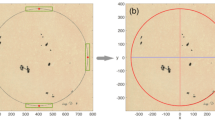Abstract
Digital images of manuscripts stored in the Galilean collection of the Central National Library of Florence are analyzed to obtain sunspot groups, their areas and heliographic positions. Overall, 142 drawings were processed. The way of drawing is usually schematic resulting in area uncertainty which may exceed a factor of two for small sunspots. We suggest that there is an upper limit of a factor of two between sunspot group numbers from the drawings and the actual ones. The computed penumbra-to-umbra ratio is consistent with modern observations. A distribution of sunspot latitudes versus time is reconstructed by means of two methods: exploiting the observation time noted by an observer and minimizing the day-to-day variability of sunspot latitudes.










Similar content being viewed by others
Notes
calsky.com (the project has been closed on October 2020).
References
Arlt, R., Vaquero, J.M.: 2020, Historical sunspot records. Living Rev. Solar Phys. 17(1), 1. DOI. ADS.
Arlt, R., Senthamizh Pavai, V., Schmiel, C., Spada, F.: 2016, Sunspot positions, areas, and group tilt angles for 1611-1631 from observations by Christoph Scheiner. Astron. Astrophys. 595, A104. DOI. ADS.
Brandt, P.N., Schmidt, W., Steinegger, M.: 1990, On the umbra / penumbra area ratio of sunspots. Solar Phys. 129(1), 191. DOI. ADS.
Bredekamp, H.: 2019, Galileo’s Thinking Hand: Mannerism, Anti-Mannerism and the Virtue of Drawing in the Foundation of Early Modern Science, de Gruyter, Berlin. ISBN 9783110539219. https://books.google.ru/books?id=4XWcDwAAQBAJ.
Carrasco, V.M.S., García-Romero, J.M., Vaquero, J.M., Rodríguez, P.G., Foukal, P., Gallego, M.C., Lefèvre, L.: 2018, The umbra-penumbra area ratio of sunspots during the Maunder minimum. Astrophys. J. 865(2), 88. DOI. ADS.
Carrasco, V.M.S., Vaquero, J.M., Gallego, M.C., Muñoz-Jaramillo, A., de Toma, G., Galaviz, P., Arlt, R., Senthamizh Pavai, V., Sánchez-Bajo, F., Villalba Álvarez, J., Gómez, J.M.: 2019, Sunspot characteristics at the onset of the Maunder minimum based on the observations of Hevelius. Astrophys. J. 886(1), 18. DOI. ADS.
Casas, R., Vaquero, J.M., Vazquez, M.: 2006, Solar rotation in the 17th century. Solar Phys. 234, 379. DOI. ADS.
Cigoli, L.: 1611, Lettere scientifiche, Cardi Ludovico (detto Il Cigoli) a Galilei Galileo, 16 settembre 1611. BNCF Gal. 89, 41r.
Cigoli, L.: 1612a, Cardi Ludovico (detto Il Cigoli) a Galilei Galileo, 23 marzo 1612. BNCF Gal. 57, 61r.
Cigoli, L.: 1612b, Cardi Ludovico (detto Il Cigoli) a Galilei Galileo, 30 giugno 1612. BNCF Gal. 89, 117r.
Cigoli, L.: 1612c, Solares maculae, prout e tubo receptae sunt inversae, Neapoli observatae ac signis notatae. BNCF Gal. 57, 104r.
Cologna, S.: 1612, Sigismondo da Colonia a Castelli Benedetto, 10 ottobre 1612. BNCF Gal. 95, 35r.
Colonna, F.: 1613, Solares maculae, prout e tubo receptae sunt inversae, Neapoli observatae ac signis notatae. BNCF Gal. 57, 78r.
Colonna, F.: 1614, Colonna Fabio a Galilei Galileo, 3 ottobre 1614. BNCF Gal. 90, 204ar.
Galaviz, P., Carrasco, V.M.S., Sánchez-Bajo, F., Gallego, M.C., Vaquero, J.M.: 2020, Soonspot: software to determine areas and sunspot positions. Solar Phys. 295(2), 17. DOI. ADS.
Galilei, G.: 1612, Appunti relativi alle Macchie Solari. BNCF Gal. 57, 68v.
Galilei, G.: 1613, Istoria E dimostrazioni intorno alle macchie solari E loro accidenti comprese in tre lettere scritte all’illvstrissimo signor Marco Velseri ..., G. Mascadi, Roma. ADS.
Gargano, M.: 2019, Della Porta, Colonna, and Fontana: the role of Neapolitan scientist at the beginning of the telescope era. J. Astron. Hist. Herit. 22(1), 45. ADS.
Hathaway, D.H.: 2013, A curious history of sunspot penumbrae. Solar Phys. 286(2), 347. DOI. ADS.
Hoyt, D.V., Schatten, K.H.: 1998, Group sunspot numbers: a new solar activity reconstruction. Solar Phys. 179(1), 189. DOI. ADS.
Jha, B.K., Mandal, S., Banerjee, D.: 2019, Study of sunspot penumbra to umbra area ratio using Kodaikanal white-light digitised data. Solar Phys. 294(6), 72. DOI. ADS.
Karoff, C., Sønderskov Jørgensen, C., Pavai Valliappan, S., Arlt, R.: 2019, Christian Horrebow’s sunspot observations – II. Construction of a record of sunspot positions. Solar Phys. 294, 78. DOI.
McIntosh, P.S.: 1990, The classification of sunspot groups. Solar Phys. 125, 251. DOI. ADS.
Mitchell, W.M.: 1916, The history of the discovery of the solar spots. Pop. Astron. 24, 428. ADS.
Muñoz-Jaramillo, A., Vaquero, J.M.: 2019, Visualization of the challenges and limitations of the long-term sunspot number record. Nat. Astron. 3, 205. DOI. ADS.
Neuhäuser, R., Arlt, R., Richter, S.: 2018, Reconstructed sunspot positions in the Maunder minimum based on the correspondence of Gottfried Kirch. Astron. Nachr. 339(4), 219. DOI. ADS.
Noyes, R.S.: 2016, Mattheus Greuter’s sunspot etchings for Galileo Galilei’s macchie solari (1613). Art Bull. 98(4), 466. DOI.
Panofsky, E.: 2013, Galileo as a Critic of the Arts, Springer, Dordrecht. ISBN 9789401762038. https://books.google.ru/books?id=QzX0CAAAQBAJ.
Petrovay, K.: 2020, Solar cycle prediction. Living Rev. Solar Phys. 17(1), 2. DOI. ADS.
Scheiner, C.: 1612, De maculis solaribus et stellis circa Jovem errantibus accuratior disquisitio, ad Mar. Velseum priscrita. Interjectis observationum delineationibus, Ad insigne pinus, Augustae Vindelicorum.
Vaquero, J.M., Vázquez, M.: 2009, The Sun Recorded Through History: Scientific Data Extracted from Historical Documents 361. DOI. ADS.
Vokhmyanin, M., Arlt, R., Zolotova, N.: 2020, Sunspot positions and areas from observations by Thomas Harriot. Solar Phys. 295(3), 39. DOI. ADS.
Vokhmyanin, M., Zolotova, N.: 2018a, Sunspot positions and areas from observations by Galileo Galilei. Solar Phys. 293(2), 31. DOI. ADS.
Vokhmyanin, M., Zolotova, N.: 2018b, Sunspot positions and areas from observations by Pierre Gassendi. Solar Phys. 293(11), 150. DOI. ADS.
Welser, M.: 1613, Welser Marcus a Galilei Galileo, 18 ottobre 1613. BNCF Gal. 57, 59r.
Acknowledgements
We are grateful to Federico Spada for translating Latin and Italian texts by Colonna and Welser. We use data from the Royal Greenwich Observatory, United States Air Force, National Oceanic and Atmospheric Administration (RGO/USAF/NOAA: solarscience.msfc.nasa.gov/greenwch.shtml), the database by Hoyt and Schatten (1998) provided by the National Geophysical Data Center (NOAA/NGDS: ngdc.noaa.gov/stp/SOLAR), historical manuscripts from the Collezione galileiana della Biblioteca Nazionale Centrale of Florence (museogalileo.it/en), the Austrian National Library (onb.ac.at), the Bibliotheque municipale de Lyon (bm-lyon.fr), the Biblioteca Nazionale Centrale di Roma (digitale.bnc.roma.sbn.it/tecadigitale), Harriot’s drawings of sunspots from the Cultural Heritage Online, vol. VIII: spots on the Sun, HMC 241 VIII (ECHO: echo.mpiwg-berlin.mpg.de/content/scientific_revolution/harriot/harriot_manuscripts, and the CalSky Project (calsky.com) by Arnold Barmettler, Switzerland.
The reported study was funded by the Russian Science Foundation according to the research project 19-72-00053.
Author information
Authors and Affiliations
Corresponding author
Ethics declarations
Disclosure of Potential Conflicts of Interest
The authors declare that they have no conflicts of interest.
Additional information
Publisher’s Note
Springer Nature remains neutral with regard to jurisdictional claims in published maps and institutional affiliations.
Supplementary Information
Below are the links to the electronic supplementary material.
Rights and permissions
About this article
Cite this article
Vokhmyanin, M., Arlt, R. & Zolotova, N. Sunspot Positions and Areas from Observations by Cigoli, Galilei, Cologna, Scheiner, and Colonna in 1612 – 1614. Sol Phys 296, 4 (2021). https://doi.org/10.1007/s11207-020-01752-7
Received:
Accepted:
Published:
DOI: https://doi.org/10.1007/s11207-020-01752-7




